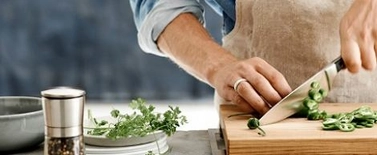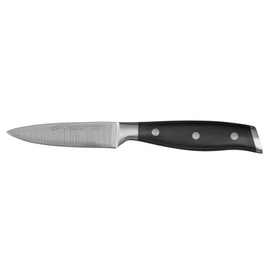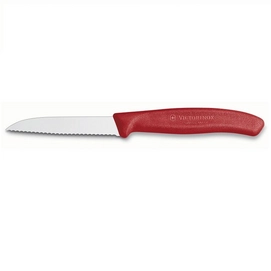Best Kitchen Knives
Types of kitchen knives

Chef's Knife
Function: Chopping meat, fish, and vegetables
The chef's knife is one of the most common knives in Dutch cuisine. It has a wide and large blade that is slightly tapered. Chef's knives are multi-functional, as they can be used to cut meat, fish, vegetables and herbs.

Filleting Knife
Function: Filleting and boning
A fillet knife is narrow and pointed. Due to the flexibility, meat or fish can be well filleted. So if you like to work with the utmost precision, choose a filleting knife.

Paring Knife
Function: Precisely chopping fruit and vegetables
This relatively small knife has a tapered blade that can be used to cut extremely accurately. The office knife is therefore suitable for precisely cutting and peeling fruit and vegetables.
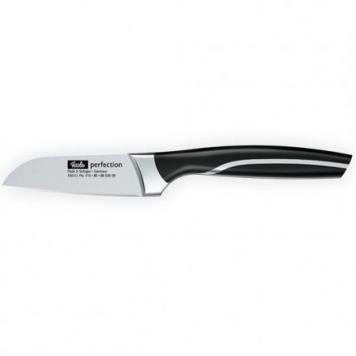
Vegetable Knife
Function: Peeling and chopping vegetables
The vegetable knife has a short blade that makes peeling, peeling and cutting a fine job. Although the vegetable knife resembles a paring knife, the former has a firmer blade.

Santoku Knife
Function: Chopping meat and vegetables
This versatile Japanese knife can be used to cut meat, fish, vegetables and poultry. Santoku knives are often sharpened on both sides.

Meat Knife
Function: Precisely chopping meat and fish
The name gives it away: the carving knife is ideally suited for cutting meat, fish or poultry. A carving knife almost always has a slim, long blade that can be used to cut precisely.

Cleaver Knife
Function: Chopping meat and vegetables
Cleavers often resemble axes, but have different functions. The cleaver most closely resembles a normal chef's knife, as it is extremely suitable for cutting vegetables and meat.

Boning Knife
Function: Precisely chopping and de-boning meat
The boning knife is ideal for easy removal of skin, tendons and fat. A boning knife generally has a long, flexible blade with which the most difficult pieces can easily be removed.
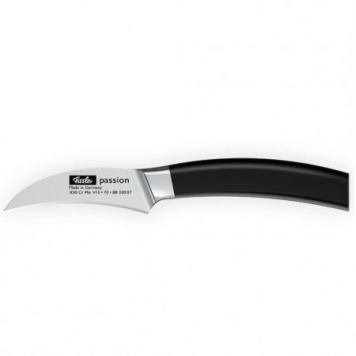
Peeling Knife
Function: Precise peeling of (round) fruit and vegetables
The peeling knife is best known as a useful aid in the preparation of potatoes. The potato peeling knife is therefore the basis of the modern peeling knife, which contains the best of the various peeling knives.
European & Japanese Knives
What are the differences?
The sharpness of a knife is determined by the edge. Two types of knives can be distinguished among the double-sided sharpened knives: European and Japanese kitchen knives.
The difference between these knives is the sharpening angle. European knives usually have a sharpening angle of about 20 degrees, while Japanese knives have a sharpening angle of about 15 degrees. This ensures that Japanese
knives are sharper than the European variants. The narrower sharpening angle of Japanese knives is possible due to the hard steel. A disadvantage of hard steel is the fact that it makes the knife more fragile.

What constitutes a good knife?
Signs of a good knife
A good knife can be recognised by the correct thickness, stability and sharpness. Because there are many specific kitchen knives available, it is important to know which properties of the knife are suitable for your intended application.
Thickness
In order to cut properly, it is important that a knife is thin. The thickness of the edge on the underside of the blade determines the sharpness of the knife. The thinner the edge, the sharper the blade. In order to be able to make a knife very thin, it must be made of hard steel. A disadvantage of this is the fact that such a knife is more vulnerable than a thicker knife made of softer steel. It is therefore important to look carefully at whether the knife is stable enough for the object to be cut.
Hardness
The ability to resist deformation or hardness gives a good indication of the life of the knife. The lifespan is the time frame in which the knife becomes dull and must be sharpened. This power is expressed in Rockwell (HRC). The higher this value, the harder the steel. A knife with a high value will remain sharp longer, but is more susceptible to damage.
Handle
In addition to the blade, the handle is also important when purchasing the best kitchen knife according to your wishes. You must make a choice between knives where the handle and blade are riveted and knives where the handle and blade are welded together. A knife in which the handle and blade are forged from one piece of metal is often seen as being of better quality and is usually also more expensive.
Our top brands

With over 40 years of experience, Diamant Sabatier is a well-known player in the kitchen knife market. With a combination of traditional craftsmanship and modern techniques, Diamant Sabatier guarantees kitchen knives of very
high quality and a long life. You often even receive a lifetime warranty for Diamant Sabatier knives.
In addition to an extensive collection of pans, the German brand WMF also has a nice range of kitchen knives in its assortment. The different types of knives are made of materials such as stainless steel, which makes these knives very sharp and durable. Choose from individual knives or a set of knives.
This Swiss brand is known for its distinctive, red pocket knives. In addition, Victorinox also has a nice collection of kitchen knives in it's collection, which are known for their thin, sharp blades that last a long time. Due to the ergonomic
handle, a Victorinox kitchen knife is very pleasant to use.
